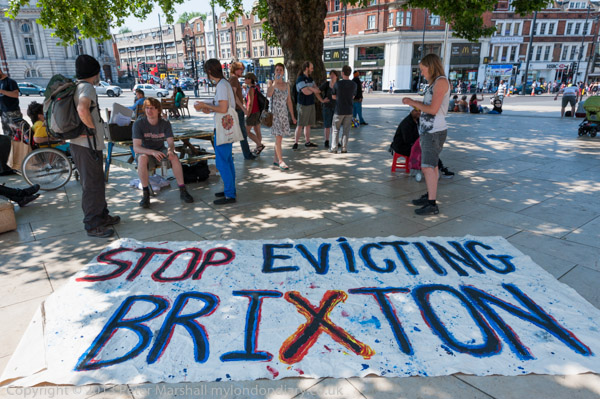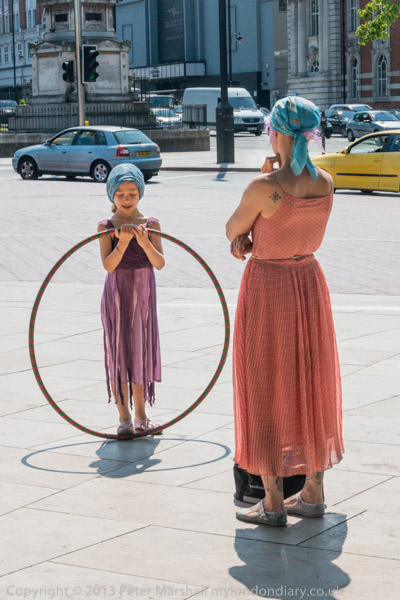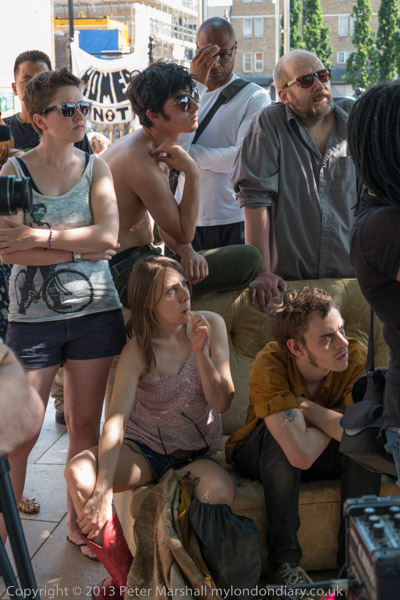
A few years ago these properties were mainly in a poor state, many squatted and near derelict. Now each block is worth millions.
Nothing is what it used to be, and certainly Brixton isn’t. First developed with large middle-class housing along the main roads out of London to the south and south-west at an easy distance from work in Westminster or the city, by the start of the 20th century it had become a largely working-class inner London area, with many of the larger houses converted to boarding houses or flats and streets of working class housing. In the 1930s it was the best shopping centre in South London, and it still has one of the best markets in London.
The London County Council and the local council built social housing in large estates around the area in the 1930s, and more followed bomb damage and slum clearance after the war. The first postwar Caribbean migrants came from Jamaica on the Empire Windrush in 1948, and were given temporary housing just up the road in the Clapham deep air-raid shelter, and they found local jobs at the nearby Labour Exchange in Coldharbour Lane in Brixton, moving out into the local boarding houses and flats, forming the nucleus of a new community in the area.
By the 1980s as well as being a centre of London’s Afro-Caribbean community, it was also a haven for white squatters, often unemployed. The area had a huge waiting list for social housing and much of the housing stock was substandard; there was very high unemployment, particularly among the black community and the crime rate was double that of any other area of London. One area was known as the ‘Frontline’, an area the police could neither understand or control, limiting themselves to occasional skirmishes which largely served to further antagonise the local mainly black population.

Preparing for the protest. The council removed the seats that used to surround this tree because they didn’t like the kind of people who sat on them.
Iused to go there occasionally, particularly to buy surplus photographic materials from a shop just a few yards away. I’d occasionally wander down the Railton Road, perhaps go into a shop and buy a drink or snack. I even took a few pictures. Occasionally I politely refused an offer to buy what could have been (and probably was) weed as I passed a small crowd of youths.
Few were surprised when there were riots in 1981 – known by some as the ‘Brixton Uprising’. More surprising that it hadn’t happened before and didn’t happen more often. What was perhaps surprising were some of the stories of the solidarity between black and white people involved in defending their area, and some of the more lurid lies in the media about what was happening.
Brixton is now rather a different place, though its history gives if a certain chic for some, and it’s not too long since I looked out of a window and saw a man in the street with a gun, and even shorter that I was last offered drugs on the street. Good transport links and its nearness to the city make it a very desirable place for young professionals. House and flat prices have soared, estate agents have taken over many of the once useful shops, and many of the once-squatted buildings – often converted into short-term lets – are now being renovated. The tenants who have little or no rights are evicted, the flats modernised and then sold or let at ridiculous prices.
There is little new social housing, and nothing affordable for those who are evicted. Even squatting is less of an option now, with recent law making squatting in residential properties a criminal offence.
Whether you choose to describe the changes as regeneration or gentrification, the consequences for many of the poorer residents of the area is the same – there is nowhere for them to live in the area once they are evicted. It is a process that is difficult to fight or even to know how to fight, as the discussion at the protest against the evictions on Rushcroft Road demonstrated. It demonstrates a lack of any concern for people involved that seems shocking in a civilised society, but we seem no longer to live in a civilised society, or at least one which is only civilised for the wealthy. As the recent report Human Development Report from the The United Nations Development Programme indicates, the UK is the most unequal society in the western world, on a par with Nigeria. Of industrialised countries only Russia is more unequal. In the UK, the poorest fifth have incomes on average one tenth of the richest fifth, and have incomes per head a third less in the US and 44% less than in the Netherlands.

This woman and child stopped for a while at the protest
And in the UK the gap is growing rapidly – twenty years ago the gap between rich and poor was only 6.7 times – it has increase by around 50% over the last 20 years. It isn’t surprising that there are problems in the poorer areas of the country, only that in general the poor are so passive about it most of the time. Of course the circuses are being trowled on thick – Olympics, Royal Wedding, Royal Jubilee, Royal Birth, a new Dr Who… – but the bread is getting thin.

People listened intently to the discussion once it got going
It wasn’t an easy event to photograph for various reasons. There was an awful lot of frustration in the air, and a certain negativity towards photographers, and really not very much happening.
There were disturbances in Brixton following the events in Tottenham over the shooting of Mark Duggan a couple of years ago, but our ‘riots’ then were relatively mild and didn’t spread a great deal. But events like these evictions do make me feel that a spring is slowly being wound up that at some point may lead to truly major insurrection. It didn’t seem likely in the former Soviet Union before it happened, nor in Libya or Egypt, but perhaps one day we will have a truly British (or, post-devolution an English and Welsh) Spring. Though I sincerely hope it won’t be another Syria.
I felt depressed as I left Windrush Square, with such rather gloomy thoughts in my mind, and was even more depressed on crossing Coldharbour Lane as I stopped to read the posters of a group of Black Hebrew Israelites or Black Jews. As I stood there the preacher started to attack a black woman passing by – her sin according to him that she was with a white man. She stood her ground and argued against this nonsense, and I felt like congratulating her. But I moved away, not wanting to get involved, and I felt bad about it.
More pictures from Brixton at Brixton Protests Gentrification & Evictions. Earlier in the day I photographed the annual International Brigade Commemoration in Waterloo, a reminder of the commitment and sacrifice of many in the 1930s.
________________________________________________________
My London Diary : Buildings of London : River Lea/Lee Valley : London’s Industrial Heritage
All photographs on this and my other sites, unless otherwise stated are by Peter Marshall and are available for reproduction or can be bought as prints.
To order prints or reproduce images
________________________________________________________